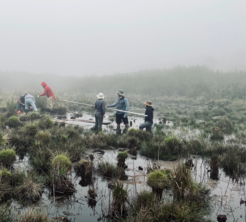Exploring the impacts of climate change on early urban settlement in Sri Lanka

Changes in land use, settlement patterns and centres of administration during the late Holocene in Sri Lanka are hypothesized to be, at least in part, responses to climatic variability during this period. Prior to 2,500 years ago the primary evidence for human activity on the island occurred in the Wet Zone and Intermediate Zone rainforests of the southwest. From 2,500 years ago, however, vast low-density urban networks with complex water management systems were developed in the northern dry zone of Sri Lanka, in a region which is currently highly vulnerable to increasing drought intensity associated with changes in the Indian Ocean Monsoon climate system. These urban settlements persisted for centuries before seemingly disappearing altogether, and urbanism returned to denser settlements in the Wet Zone.
This project, part-funded by the National Geographic Society, aims to investigate how changes in the Indian Ocean Monsoon system affected Sri Lanka’s varied environmental zones during the late Holocene by analysing a range of proxies from sediment cores, including compound specific isotope analysis of plant wax biomarkers (δ13C and δ2H), charcoal and pollen analysis. The results of this project will allow us to explore how human societies, with a particular focus on urban settlements in the arid north of the island, interacted with past environmental and hydroclimatic change. This includes the attainment and analysis of palaeoenvironmental archives closely associated with urban occupation in the northern Dry Zone.
By examining how past urban settlements in Sri Lanka adapted to climatic variability through shifts in land use, water management, and settlement patterns, this research will provide insights into the long-term co-evolution of human societies and Earth system dynamics.











